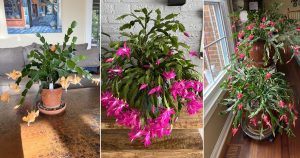Is Your Succulent Too Close to the Window? Just figure out the ways to avoid winter sunburn on succulents right here!
There is a common misconception that succulents thrive in all light conditions year-round. Many gardeners make the mistake of placing them too close to a sunny window during winter. But this is where everything goes wrong! Let’s talk about winter sunburn on succulents, what they look like, and how to deal with them.
Can Winter Sun be Harsh for Succulents?
The winter sunlight might seem gentle, but its intensity can increase due to the low angle of the sun and the reflection from surfaces like snow or concrete. This concentrated light can scorch the foliage of succulents.
So, keep your succulents in spots where they can get enough bright indirect light. You can also use sheer curtains or UV-protective window films to diffuse the blazing sunlight! If you notice sunburn symptoms, move the plant to a shaded spot immediately and prune severely damaged leaves to prevent bacterial infections.
Fun Fact: Did you know the waxy coating on some succulents helps them reflect sunlight? If this layer is damaged due to rough handling or overwashing the plant becomes more susceptible to sunburn.
How to Spot Sunburn on Succulents?
Sunburn is caused when the plant’s tissue is damaged from overexposure to the harsh UV light of the sun. You can spot sun damage on your succulents if they have bleached or discolored patches on their foliage. Some can get crispy edges or spots on their leaves, and sometimes, in severe cases, the growth is stunted or leaves fall off pretty frequently.
For example—Sedums in the early stages of sunburn appear discolored when exposed to direct sunlight for long hours. This is when you should shift them to shade for 6-7 days to heal. If you overlook this, the next you will observe burnt, crisp leaves that cannot be reversed rather than just cut off.
How to Avoid Sunburn in Winter?
1. Avoid Direct Sunlight
For some succulents, direct sunlight is somewhat good enough for a few hours like Jade plants, Agave or Cacti. But for some, it works the other way round, it causes damage to their foliage especially. What you can do is place them in bright spots with indirect sunlight or pair them up with sun-loving plants to make a shield over them, while they enjoy the dappled light!
You can also provide shade by putting up a green shade net on top of your succulent garden if it is outdoors. This way your plants can enjoy the openness and airy environment, protected under the sun!
2. Find the Perfect Window Spot
South-facing windows are the brightest and warmest in the winter because they are ideal for light-loving plants like Aloe and Jade. However, overexposure can still bring some harm. On the other hand, east-facing windows are another great option, as they provide gentle morning light, which is perfect for succulents that prefer less intense rays.
Tip: Rotate your succulents weekly to ensure even growth and prevent one side from being overexposed to sunlight.
3. Go with the UV-Blocking Films
If you live in a region with intense sunlight, consider using UV-blocking films for your windows. It helps to reduce the harmful effects of sunlight without dimming your room. Additionally, terrariums or glass enclosures with frosted sides can be great for maintaining optimal light levels.
Fun Fact: Succulents like Snake plants are tolerant to low-light conditions and can thrive even in rooms with minimal light.
4. Acclimatize Before Shifting
Many gardeners make the mistake of shifting their plants directly to a bright spot in the winter without a proper transition. This actually leads to temperature and light shock in your plants and the damage is doubled.
The best thing you can do is to gradually transition the shifting and slowly increase the exposure to direct light. Start by keeping your succulents under the sun for 1 hour for 2-3 days and gradually increase the time after 3 days. This technique helps a lot to make your succulents comfortable in the daylight.
5. Take Care of the Wax Layer
Some succulents have a waxy layer on their foliage and stems. This layer works like a natural sunscreen by protecting the softer layer beneath it from the ultraviolet light rays. To protect this layer you should keep these things in mind.
Do not expose your succulents to long daylight hours, bring them to shade during the afternoon blazing sunny hours, and avoid using too many chemical sprays on your succulents. You must also avoid touching the plants too frequently and exposing them to friction!
6. Monitor Frequently
As a plant parent, keeping an eye on your green babies is something that should be in your routine, if you want them to be healthy and happy. So, always look out for any signs of unusual color changes, pest infestations, and other damages. Because as early as you notice the better it is to treat them.
Besides, it is not a tough job, you can do it every 3-4 days while you sip your morning coffee or evening snack as you sit beside them!
Some succulents, such as Haworthia species, Crassula ovata, Aeonium ‘Zwartkop,’ and Echeveria species, are more prone to sunburn than others. Hopefully, this article has answered all your questions about preventing sunburn in succulents. If you have more questions, write to us—we’d be delighted to help another plant parent!
















